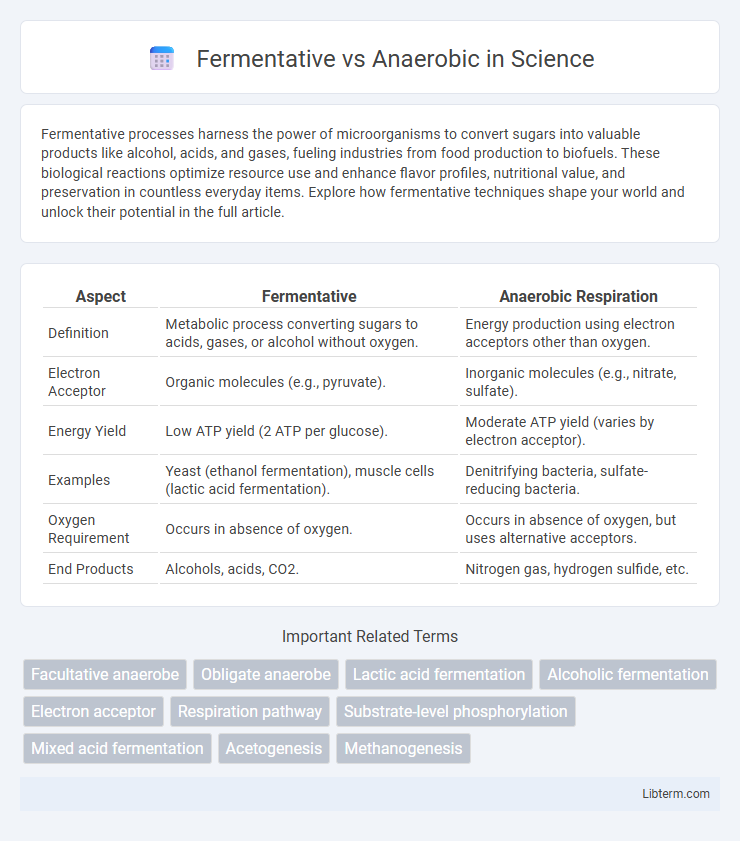Fermentative processes harness the power of microorganisms to convert sugars into valuable products like alcohol, acids, and gases, fueling industries from food production to biofuels. These biological reactions optimize resource use and enhance flavor profiles, nutritional value, and preservation in countless everyday items. Explore how fermentative techniques shape your world and unlock their potential in the full article.
Table of Comparison
| Aspect | Fermentative | Anaerobic Respiration |
|---|---|---|
| Definition | Metabolic process converting sugars to acids, gases, or alcohol without oxygen. | Energy production using electron acceptors other than oxygen. |
| Electron Acceptor | Organic molecules (e.g., pyruvate). | Inorganic molecules (e.g., nitrate, sulfate). |
| Energy Yield | Low ATP yield (2 ATP per glucose). | Moderate ATP yield (varies by electron acceptor). |
| Examples | Yeast (ethanol fermentation), muscle cells (lactic acid fermentation). | Denitrifying bacteria, sulfate-reducing bacteria. |
| Oxygen Requirement | Occurs in absence of oxygen. | Occurs in absence of oxygen, but uses alternative acceptors. |
| End Products | Alcohols, acids, CO2. | Nitrogen gas, hydrogen sulfide, etc. |
Introduction to Fermentative and Anaerobic Processes
Fermentative processes involve the breakdown of organic substrates by microorganisms in the absence of oxygen, producing energy and metabolites like alcohols, acids, and gases. Anaerobic processes similarly occur without oxygen but encompass a broader range of microbial pathways including methanogenesis, which converts organic matter into methane and carbon dioxide. Both processes are critical in natural ecosystems and industrial applications such as waste treatment and biofuel production due to their ability to generate energy from organic materials without oxygen.
Defining Fermentation: Key Concepts
Fermentation is a metabolic process that converts sugars into acids, gases, or alcohol in the absence of oxygen, distinguishing it from broader anaerobic respiration which may use alternative electron acceptors. Key concepts include the regeneration of NAD+ from NADH, allowing glycolysis to continue producing ATP without oxygen, and the production of specific end-products such as lactic acid in lactic acid fermentation or ethanol and carbon dioxide in alcoholic fermentation. This process is utilized by various microorganisms, including yeast and certain bacteria, in industries like food production, biofuel generation, and pharmaceuticals.
Understanding Anaerobic Respiration
Anaerobic respiration is a metabolic process where cells generate energy without oxygen, using alternative electron acceptors such as nitrate, sulfate, or carbon dioxide. Unlike fermentative metabolism, anaerobic respiration involves an electron transport chain that produces more ATP, enhancing cellular energy efficiency. Key microorganisms like sulfate-reducing bacteria and denitrifying bacteria utilize anaerobic respiration in oxygen-depleted environments to sustain energy production.
Core Differences: Fermentation vs Anaerobic Respiration
Fermentation and anaerobic respiration both occur in the absence of oxygen but differ fundamentally in electron acceptors and energy yield. Fermentation uses organic compounds as electron acceptors, producing byproducts like lactic acid or ethanol with minimal ATP generation. Anaerobic respiration employs inorganic molecules such as nitrate, sulfate, or carbon dioxide as terminal electron acceptors, resulting in higher ATP production through an electron transport chain.
Types of Fermentative Pathways
Fermentative pathways include lactic acid fermentation, alcohol fermentation, and mixed acid fermentation, each distinguished by the end products formed during the breakdown of glucose without oxygen. Anaerobic respiration differs by utilizing electron acceptors other than oxygen, such as nitrate, sulfate, or carbon dioxide, supporting ATP production without fermentation byproducts. The diversity of fermentative pathways enables microorganisms to adapt to various environmental niches by producing specific metabolites like ethanol, lactic acid, or hydrogen gas.
Energy Yield Comparison
Fermentative processes yield significantly less energy, producing only 2 ATP molecules per glucose molecule, whereas anaerobic respiration can generate up to 30-32 ATP molecules depending on the electron acceptor used. Fermentation relies solely on substrate-level phosphorylation, while anaerobic respiration utilizes an electron transport chain to maximize ATP production. This distinction is critical in environments lacking oxygen, where organisms must optimize energy extraction efficiency for survival.
Industrial and Biological Applications
Fermentative processes harness microorganisms to convert substrates into valuable products like ethanol, organic acids, and biogas under anaerobic conditions, widely applied in biofuel production and waste valorization industries. Anaerobic digestion, a subset of anaerobic metabolism, is extensively used in wastewater treatment and biogas generation, leveraging microbial consortia to degrade complex organic matter in the absence of oxygen. Industrial applications benefit from optimizing parameters such as temperature, pH, and substrate concentration to enhance yield and efficiency in both fermentative and anaerobic bioprocesses.
Organisms Involved in Each Process
Fermentative processes primarily involve facultative anaerobes such as Saccharomyces cerevisiae, which convert sugars to ethanol and carbon dioxide, and lactic acid bacteria like Lactobacillus species, responsible for producing lactic acid. Anaerobic respiration is carried out by obligate anaerobes such as methanogens (Methanobacterium) and sulfate-reducing bacteria (Desulfovibrio), utilizing electron acceptors other than oxygen like sulfate, nitrate, or carbon dioxide. These distinct microbial communities reflect adaptation to oxygen-deprived environments with different metabolic pathways and energy yields.
Environmental and Health Impacts
Fermentative processes produce fewer greenhouse gases compared to anaerobic digestion, which can emit methane if not properly managed, influencing climate change effects. Fermentation typically generates organic acids that can improve soil health when applied as biofertilizers, whereas anaerobic digestion produces biogas, offering renewable energy but posing risks of pathogen survival if digestate is misused. Managing waste with fermentative methods reduces odor and hazardous emissions, benefiting air quality and public health, while anaerobic systems require careful oversight to prevent environmental contamination and ensure pathogen reduction.
Future Perspectives and Innovations
Fermentative and anaerobic processes are pivotal for advancing sustainable energy production, with innovations targeting enhanced microbial consortia and genetic engineering to maximize biogas yields and substrate utilization. Future perspectives emphasize integrating AI-driven optimization and real-time monitoring systems to improve process stability and efficiency in industrial applications. Emerging technologies in bioelectrochemical systems and synthetic biology are expected to revolutionize anaerobic digestion by enabling tailored metabolic pathways and higher energy recovery.
Fermentative Infographic

 libterm.com
libterm.com